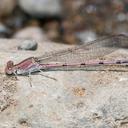United States and Canada
The frons and top of the head in males is a reddish-violet color and is largely unmarked, except for a dark postocular bar extending medially from the margin of each eye. The back of the head is pale and the thorax is reddish-violet. The pterothorax bears a dark thin middorsal stripe about a forth as wide as the pale antehumeral stripe. The dark humeral stripe exists as a hairline and is ne ver forked, but usually widened at each end, occasionally with the middle of the stripe completely lacking. The legs are pale with brown stripes on the outer surfaces. There are 4 and 3 postquadrangular cells in the fore- and hindwing, respectively. The abdomen reddish-violet with a black spot laterally on the apical forth of segments 2-6. Spots on segments 4-6 are often confluent with a black apical ring. The lateral spot on segment 7 is drawn out anteriorly to form a stripe nearly extending the length of the segment. Segments 8-10 are bluish with a dark lateral stripe that may or may not be present, especially on 10. The caudal appendages are pale with the cerci about a fifth as long as the paraprocts. The female is similarly patterned to the male, but the pale ground color is brown instead of violet. Segments 9-10 lack a ventrolateral stripe which may be faint on segment 8. The mesostigmal plates are bilobed posteriorly and mesepisternal tubercles are absent.
Size: Total length: 32-35 mm; abdomen: 25-27 mm; hindwing: 20-22 mm.
Similar Species (south-central US): Variable Dancer (A. fumipennis) is a deeper violet color and has a black ventrolateral stripe on segments 8-10, not just 8 as in Amethyst Dancer. Segment 7 is largely black and the humeral stripe is forked in both Variable Dancer and Lavender Dancer (A. hinei). The postoccular spots in Lavender Dancer are also more broadly outlined with black.
Habitat: Small desert streams.
Natural History: This species was only recently found in west Texas and New Mexico where it is no doubt more widely distributed than our current knowledge reveals. At present details of its biology are unknown.
Distribution: Southwestern U.S., Arizona, New Mexico and Texas; also south through Mexico to Guatemala.
Source: Abbott, J.C. 2006-2010. OdonataCentral: An online resource for the distribution and identification of Odonata. Available at OdonataCentral.
Edited by Drew Weber (9/24/2015).
